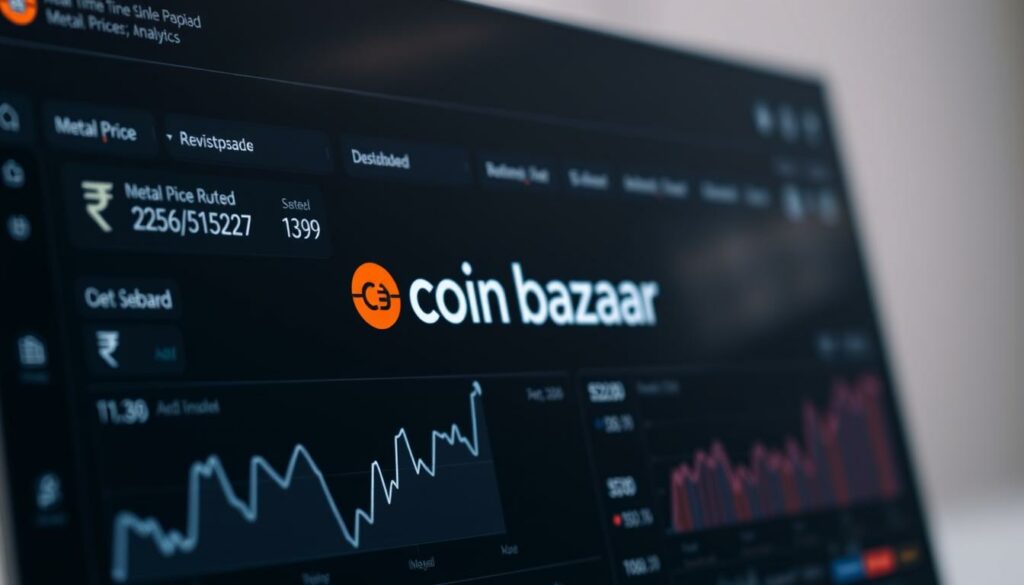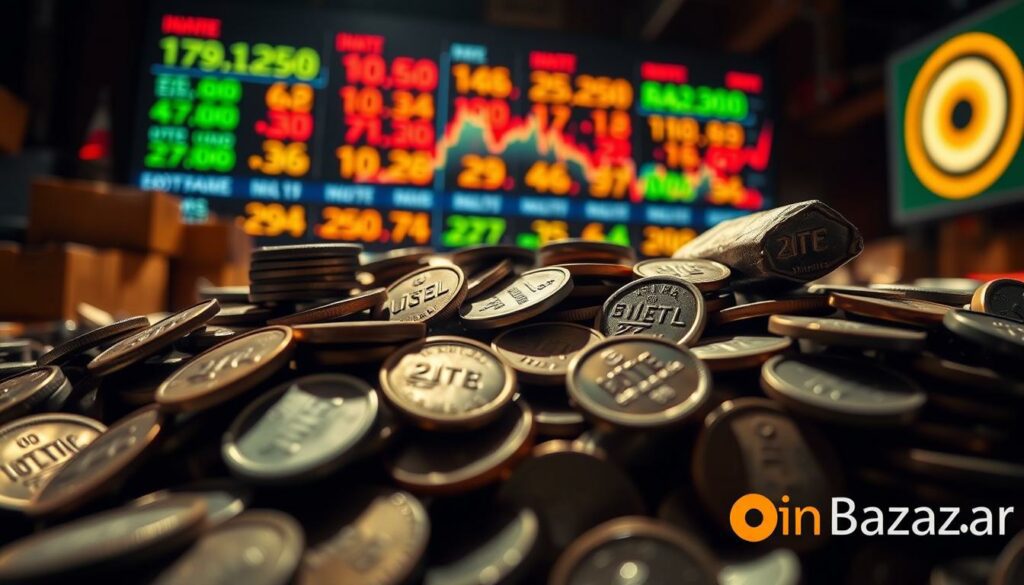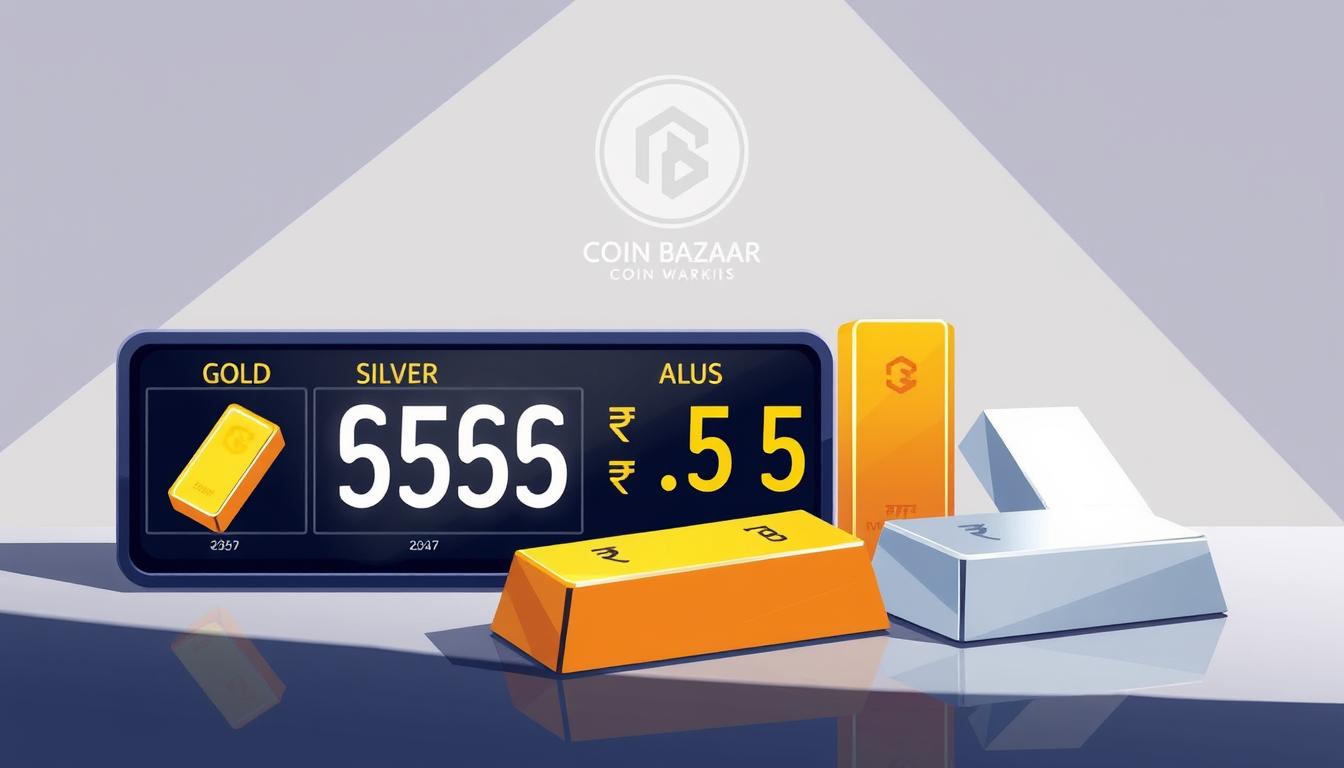In the fast world of metal trading, staying ahead is key. Knowing the current metal prices is crucial for smart decisions. The Shanghai Metal Market (SMM) is important for giving real-time metal price feeds. This helps you act fast when the market changes.
The 15-minute rule is a big deal in metal trading. Market updates can greatly affect your trading choices and profits. With up-to-the-minute data, you can grab opportunities and avoid big losses.
Key Takeaways
- Real-time metal price feeds are essential for informed trading decisions.
- The Shanghai Metal Market (SMM) provides crucial data on immediate purchase and delivery prices.
- The 15-minute rule can significantly impact your trading profitability.
- Staying updated with metal market updates is vital for success.
- Real-time data enables you to react quickly to market fluctuations.
The Power of the 15-Minute Rule in Metal Trading
In the fast world of metal trading, the 15-minute rule is key. It shows how important it is to have real-time metal price feeds. This helps make quick trading decisions.


Defining the Critical Time Window in Metal Markets
The 15-minute window is when market prices update to show current conditions. SMM’s price assessments are seen as reliable. They help traders worldwide understand Chinese markets.
How 15 Minutes Can Make or Break Your Profit Margins
Getting live metal prices in 15 minutes can greatly affect your trading. If prices are delayed, you might miss good chances or end up with bad trades. This can hurt your profits. Real-time data lets you stay on top of trends and make smart choices for better returns.
Knowing metal price trends and the metal price index is vital. These tools help traders understand market shifts and predict future trends. This way, they can handle live metal prices better.
Metal Price Volatility: Why Every Minute Counts
In the world of metal trading, volatility is always there. It can either make or break your investments. The metal market sees quick price changes due to many factors. It’s key to keep up with daily metal prices.


Factors Driving Rapid Price Fluctuations
Many things cause metal prices to change fast. Global economic trends, supply chain issues, and world events are some of them. Knowing these factors helps you make smart choices in the metal market. Looking at historical metal prices can help spot trends.
Measuring Volatility in Different Metal Categories
Not all metals are the same when it comes to price changes. Base metals like copper and aluminum are more volatile than precious metals. Keeping an eye on metal price forecast reports helps you stay ahead.
Case Study: Price Swings in Aluminum and Steel Markets
Aluminum and steel markets show big price swings. SMM reports say aluminum prices can change quickly because of global supply and demand shifts. Steel prices are affected by raw material costs and government policies. Keeping up with daily metal prices helps you make quick, smart choices.
To deal with metal price volatility, staying informed is key. Use metal price forecast tools and look at historical metal prices. This way, you can make better investment choices.
The Evolution of Metal Price Reporting Systems
Metal price reporting has changed a lot, moving from daily bulletins to updates in milliseconds. This big change came from new digital technology. It has made metal market updates more timely and accurate.
From Daily Bulletins to Millisecond Updates
Before, metal prices were reported daily or weekly. This left people with old information. Now, digital platforms offer real-time price updates. This helps everyone make better decisions.
Intrinio’s US Stock Prices API is a great example. It gives real-time and delayed stock prices. This shows how technology has improved price reporting.
How Digital Transformation Revolutionized Price Transparency
Digital transformation has made metal market prices more transparent. Now, businesses can quickly respond to price changes. This transparency has made the market more competitive.
Prices now better show what’s happening with supply and demand. The move to digital has also made it easier to share detailed market analysis. This helps everyone make better choices.
Real-Time vs. Delayed Metal Price Feeds: The Actual Cost Difference
In the fast world of metal trading, the choice between real-time and delayed price feeds matters a lot. As a trader or manufacturer, knowing the cost difference is key.
Calculating Financial Impact of the 15-Minute Lag
A 15-minute delay in metal price info can cost you a lot. If metal prices change fast, a delayed feed might mean missing a good trade or losing money.
For example, a real-time SIP feed costs $10,000 a month. But, delayed data is just $250 a year. The delayed feed seems cheaper at first. Yet, the losses from delayed info could be much higher than the savings.
Industries Most Vulnerable to Delayed Information
Some industries suffer more from delayed metal price info. These include:
- Manufacturing: Companies that use metals need current prices to buy wisely.
- Trading: Traders who buy and sell metals fast need up-to-date prices.
- Investment: Investors who want to make money from metal prices need real-time data.
ROI Analysis of Premium Price Feed Subscriptions
Deciding if a premium price feed is worth it? Look at this ROI analysis:
| Category | Real-Time Feed | Delayed Feed |
|---|---|---|
| Cost | $10,000/month | $250/year |
| Potential Loss | Minimal | Significant |
| ROI | High | Low |
By comparing the losses from delayed info to the cost of real-time feeds, you can choose wisely for your business.
Current Metal Prices: Accessing and Interpreting Live Data
To trade metals well, you need the latest prices. Knowing live metal prices helps you make better choices and increase profits.
Leading Platforms for Real-Time Price Information
Many sites give you real-time metal prices. SMM and Barchart.com are top choices. They offer detailed and accurate prices for all traders.
- SMM: Known for its detailed market analysis and real-time updates.
- Barchart.com: Offers historical data alongside current prices, enabling trend analysis.
Understanding Bid-Ask Spreads and Price Formations
When looking at live metal prices, knowing bid-ask spreads and price formations is key. Bid-ask spreads show market liquidity and costs. Price formations predict future prices based on past trends.
Bid-ask spreads are the gap between what buyers and sellers want. Narrow spreads mean a liquid market. Wide spreads mean less liquidity.
Verifying Data Accuracy Across Multiple Sources
To trust metal price index data, check it from different places. This way, you spot any errors and get a clear market view.
| Source | Real-Time Data | Historical Data |
|---|---|---|
| SMM | Yes | Yes |
| Barchart.com | Yes | Yes |
By checking data from various sources, you make smarter choices. This keeps you competitive in the metal trading world.
The Indian Metal Market Landscape
To understand the Indian metal market, we need to know its structure and key trading hubs. It’s influenced by both local and global factors. This makes it a complex and dynamic ecosystem.
Structure and Unique Characteristics of India’s Metal Exchanges
India’s metal exchanges are vital in the trading landscape. They are not just for buying and selling metals. They also set prices based on local demand and global trends.
The Indian Metal Exchange and Multi Commodity Exchange (MCX) are leaders. They trade metals like aluminum, copper, and zinc.
These exchanges aim for transparency and efficiency. They offer contracts for various market participants, from hedgers to speculators.
Key Metal Trading Hubs in Mumbai, Delhi, and Kolkata
Mumbai, Delhi, and Kolkata are key metal trading hubs. Mumbai is the financial capital with major exchanges like MCX. Delhi and Kolkata also have a big role, with many consumers and producers.
These hubs are not just for trading. They are also centers for metal consumption and production. They are near major ports and industrial centers, making import and export easier.
How Indian Metal Prices Correlate with Global Markets
Indian metal prices follow global market trends. Prices are influenced by global supply and demand, currency changes, and geopolitical events.
Prices in India move with international prices. For example, if global copper prices rise, Indian copper prices will likely do the same.
Regulatory Framework Affecting Price Reporting in India
The regulatory framework in India shapes the metal market. Bodies like the Securities and Exchange Board of India (SEBI) oversee exchanges. They ensure they operate transparently.
SEBI’s rules affect price reporting. They make sure prices are accurate and reflect the market. This is key for investor confidence and market integrity.
Metal Price Index Mechanisms and Their Importance
In the world of metal trading, price indices are key benchmarks. They give a standard way to measure metal prices. This helps traders, investors, and manufacturers understand market trends and make smart choices.
Major Global and Indian Metal Price Indices Explained
Many important metal price indices are recognized worldwide. The London Metal Exchange (LME) Index is a top one, showing prices of metals like copper and aluminum. In India, the Indian Metal Exchange (INMEX) and local exchanges have their own indices. These are vital for seeing how the regional markets work.
These indices are made from spot prices, futures contracts, and other market data. Knowing how they are made helps us understand their changes and what they mean for metal prices.
How Index Calculations Impact Contract Pricing
The way metal price indices are calculated affects contract prices. Most contracts are based on a certain index. For example, a contract might be set at “LME Copper Index + premium/discount.” Changes in the index can greatly change the contract price, affecting both buyers and sellers.
“The accuracy of metal price indices is paramount for fair and transparent trading. Any discrepancies or biases in index calculation can lead to market distortions and affect trading decisions.”
Using Indices to Benchmark Your Purchasing Performance
Metal price indices are not just for traders; they help manufacturers and buyers too. By comparing their buying prices to the index, companies can see how they’re doing. This is key in a market where prices can change fast.
| Index | Description | Key Metals |
|---|---|---|
| LME Index | Reflects prices of major metals on the London Metal Exchange | Copper, Aluminum, Zinc |
| INMEX Index | Tracks metal prices on the Indian Metal Exchange | Copper, Aluminum, Steel |
By using metal price indices well, businesses can get better at understanding the market. They can improve their buying strategies and deal with the challenges of metal trading more confidently.
Historical Metal Prices: Leveraging Past Data for Future Decisions
Looking at past metal prices can show patterns that help traders and investors. By knowing historical metal prices, you can make better choices for future investments.
Pattern Recognition in Multi-Year Price Trends
Historical data from places like SMM and Barchart.com shows long-term trends. For example, looking at copper and aluminum prices over 10 years can spot patterns.
Key observations include:
- Long-term cycles influenced by global economic trends
- Seasonal demand variations
- Impact of geopolitical events on metal prices
Seasonal Variations in Key Metal Categories
Each metal has its own seasonal price changes. For instance, aluminum prices go up in summer because of construction demand.
| Metal | Seasonal Price Variation | Average Annual Change |
|---|---|---|
| Copper | Higher demand in spring and summer | 8-10% |
| Aluminum | Surge in summer due to construction | 5-7% |
| Zinc | Stable with minor fluctuations | 3-5% |
Building Comparative Models with Historical Data
You can create models with historical data to predict metal prices. By looking at past trends and current market conditions, you can forecast prices more accurately.
For example, comparing historical price data with current market indicators can help you identify potential future price movements.
By using historical metal prices, you can improve your investment plans. This way, you can make smarter choices in the metal trading market.
Implementing the 15-Minute Rule in Your Business Operations
Using the 15-minute rule can really boost your profits in metal trading. It lets you make quick, smart choices with live price updates. This keeps you ahead of others in the market.
Technical Integration of Real-Time Price Feeds
To start, add real-time price feeds to your system. Pick a trusted data source and make sure your tech can handle fast data. Real-time data feeds give you the latest metal prices. This lets you act fast when the market changes.
Experts say, “The secret to good trading is quick, accurate data.” So, having a strong tech setup is key for your trading.
Creating Automated Decision Protocols Based on Price Triggers
With real-time data, set up auto-decision rules based on prices. Decide on price points for buying or selling metals. This makes your trading faster and less prone to mistakes.
- Define clear price thresholds for different metals.
- Set up automated protocols for buying and selling.
- Regularly review and adjust your protocols based on market conditions.
Training Your Team to Respond to Rapid Market Movements
Technology is crucial, but training your team is just as important. Teach them to understand and act on real-time data. This helps them make smart choices when needed.
“The ability to respond quickly to market changes is what differentiates successful traders from others.”
Case Study: How an Indian Manufacturing Firm Saved ₹3.5 Crore
An Indian firm used the 15-minute rule to save ₹3.5 Crore. They integrated live prices and set up auto-decision rules. This shows how the 15-minute rule can save money.
By following these steps and learning from others, you can make your business more profitable. The 15-minute rule is a game-changer in metal trading.
Metal Price Forecasting Techniques for Indian Markets
Accurate metal price forecasting is key to success in India’s metal industry. As the market changes, businesses need to use advanced forecasting methods to stay competitive.
AI and Machine Learning Applications in Price Prediction
Artificial intelligence (AI) and machine learning (ML) are changing how we forecast metal prices. These technologies can look at huge amounts of data, find patterns, and make accurate predictions. Using AI and ML, businesses can get ahead in the market.
Key benefits of AI and ML in metal price forecasting include:
- Improved accuracy in predictions
- Ability to process large datasets quickly
- Identification of complex patterns not visible to human analysts
Incorporating Monsoon Patterns and Seasonal Factors
India’s metal markets are affected by seasonal changes, like the monsoon. The monsoon can change demand for metals, especially those used in building projects. By adding these seasonal factors to forecasts, businesses can better predict price changes.
For example: A strong monsoon can increase demand for metals like steel and aluminum because of government building projects. Forecasting models that consider these seasonal changes can give more accurate price predictions.
Expert Analysis vs. Algorithmic Forecasting
Expert analysis has long been used for metal price forecasting. But, algorithmic forecasting is becoming more popular. Algorithmic models can quickly process lots of data without human bias.
| Criteria | Expert Analysis | Algorithmic Forecasting |
|---|---|---|
| Speed | Slower, dependent on human analysis | Faster, can process data in real-time |
| Accuracy | Subject to human error and bias | More objective, based on data-driven models |
Building Your Own Forecasting Dashboard
To use metal price forecasting well, businesses can create their own dashboards. These dashboards can use data from many sources, like current prices, economic data, and weather.
Steps to build a forecasting dashboard:
- Identify relevant data sources
- Select appropriate forecasting models (e.g., AI, ML, statistical models)
- Integrate data sources into the dashboard
- Regularly update and refine the forecasting models
By following these steps and using advanced forecasting methods, Indian businesses can better predict metal prices. This helps them make smart decisions.
Daily Metal Price Monitoring: Establishing an Effective Routine
Keeping an eye on metal prices every day can really help your trading. Knowing the current prices and trends lets you make smart choices. This can improve your trading plan.
Critical Checkpoints Throughout the Trading Day
To track metal prices well, find key times during the day. These times help you keep up with price changes. This way, you can make better decisions.
- Morning price updates to start your trading day
- Mid-day checks to adjust to market changes
- End-of-day analysis to plan for the next day
Setting Up Customized Alerts for Price Thresholds
Custom alerts for price levels can make trading easier. They let you quickly react to big price changes. You don’t have to watch the market all the time.
Steps to set up customized alerts:
- Identify key price thresholds for your trading strategy
- Use a reliable metal price tracking platform
- Configure alerts to notify you of price changes
Coordinating Purchasing Decisions with Price Movements
Linking your buying plans with price changes is key to making more money. Look at market trends and adjust your buying plan as needed.
| Price Movement | Purchasing Decision |
|---|---|
| Price Increase | Consider immediate purchasing or adjusting your strategy |
| Price Decrease | Evaluate potential savings and adjust your purchasing schedule |
By having a good daily routine for checking metal prices, you can lead in the market. You’ll make smart trading choices.
Beyond the 15-Minute Rule: Complementary Market Intelligence
The 15-minute rule is key, but more market insights can boost your trading plan. To make smart choices in metal markets, you must stay ahead. Use different market indicators to do this.
Supply Chain News That Signals Price Movements
Supply chain issues can really change metal prices. For example, mine closures or transport problems can cause prices to go up or down. Keeping up with these news can help you predict and act on price changes.
Government Policy Changes Affecting Metal Markets
Government actions, like tariffs or subsidies, can greatly affect metal prices. Tariffs on metals can raise prices, while subsidies can change global supply. It’s important to know about these policy changes to make good trading choices.
Emerging Technologies Disrupting Traditional Trading Patterns
New tech like blockchain, AI, and IoT is changing metal trading. These tools can make trading clearer, more efficient, and provide instant data. Knowing how these techs work can help you stay ahead in the market.
Adding these extra market insights to your strategy can help you make better choices. This way, you can lead in the fast-changing metal markets.
Conclusion: Mastering the 15-Minute Advantage
You now know how the 15-minute rule can change your metal trading. To use this advantage, keep up with real-time metal prices. This helps you make smart choices quickly.
Being ahead in the market can be just 15 minutes away. So, having real-time data is key for your success.
To stay on top, add real-time metal prices to your trading plan. It’s not just about knowing current prices. You also need to understand live data and forecasts.
This way, you can handle the ups and downs of metal markets better. And make trades that are more likely to be profitable.
Many things affect metal prices, like global trends and local demand. By mastering the 15-minute rule, you can quickly adapt to these changes. This keeps your business quick and competitive in the fast world of metal trading.














